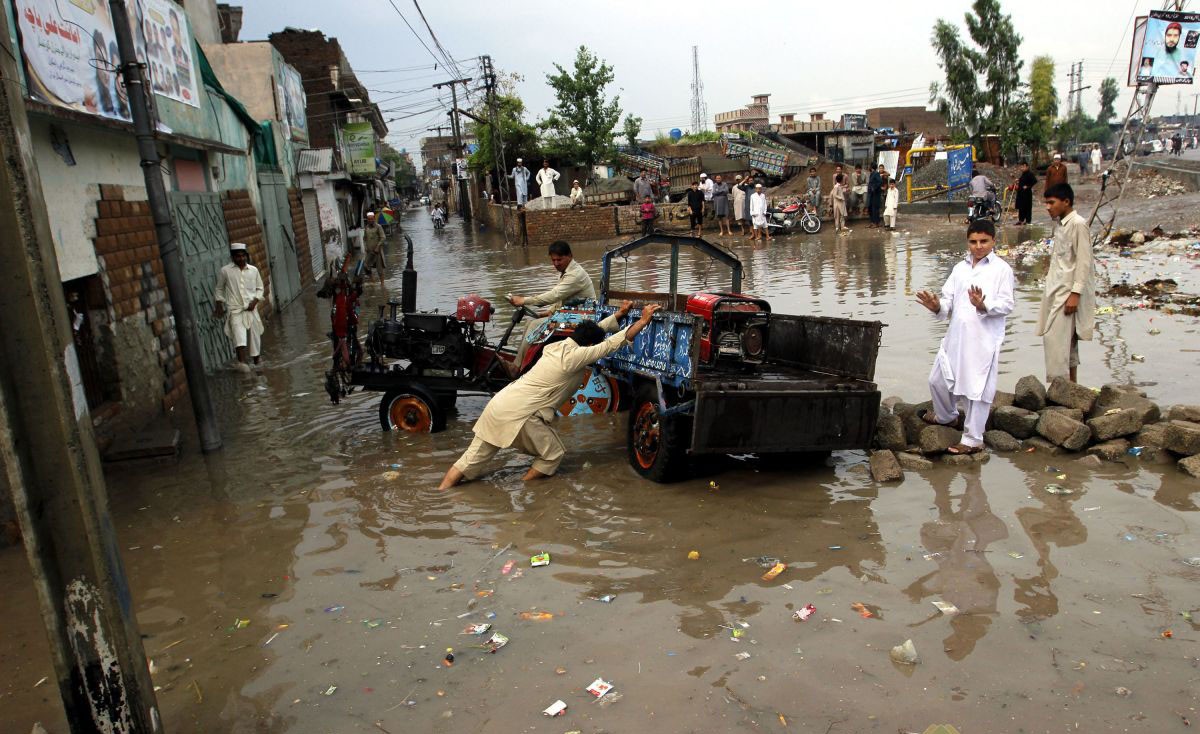
Peshawar is still reeling from destruction wreaked by the cyclone last Sunday

It became so dark 40 minutes before sunset on April 26 that motorists had to switch on headlights of their vehicles to find their way. And then, suddenly, a windstorm, followed by hailstorm and heavy rains hit Peshawar along with parts of the adjacent Nowshera and Charsadda districts.
The destruction caused by the cyclone, estimated to be 120 km/hr, said to be third of its kind witnessed in Pakistan, was massive. It uprooted electricity poles, huge signboards and trees in the city. The downpour weakened the dilapidated buildings, razing a number of them to the ground.
In Wahid Garhi, a rural town of Peshawar district, vegetable seller Shahpur’s wife, four children and his two nephews had to run into their room for shelter. They didn’t know that they would be buried in their own room.
His was not the only family. In Pakha Ghulam, another family died in the same way after roof of their house collapsed.
Two fruit traders were killed when a veranda in the main fruit market on GT Road caved in.
A young assistant professor of the University of Peshawar, Ali Askar was killed when a tree fell on his car on Charsadda Road.
It uprooted the toll plaza at the Motorway in Chamkani. Electricity supply to most parts of Peshawar, Charsadda and Nowshera remained suspended for several hours as the Pesco installations were destroyed.
The controversy over whether or not the meteorological department had issued any warning of harsh weather or cyclone aside, one thing is clear that none of the government departments were ready for such a large-scale disaster. There was complete chaos all over.
Gradually, Rescue 1122 came to rescue people. Ambulances started bringing the victims to Lady Reading Hospital (LRH). After sensing the intensity of the damage and casualties, the Khyber Pakhtunkhwa government declare emergency in all the three major civil hospitals of Peshawar, including LRH, Khyber Teaching Hospital and Hayatabad Medical Complex apart from Combined Military Hospital (CMH).
Fallen trees and poles everywhere hampered relief activities for long.
The areas that were hit hard by the cyclone were those located on the northeast of Peshawar and its adjacent parts of Nowshera and Charsadda. These included villages on Grand Trunk Road, Charsadda Road, Dilazak Road and others.
Army troops were dispatched to participate in rescue operations in the affected areas.
"The windstorm coupled with hailstorm and heavy rain scared everyone in my family. The children were crying throughout as we were praying to seek Allah’s help," recalls Niaz Mohammad of Gulozai village on Dilazak Road. He recounts that while they all gathered in one room, their neighbours wall collapsed on their roof. "Crops worth millions were destroyed as well."
The process of repair and assessment has now begun. People have started repairing their damaged and destroyed rooms, verandas and shelters.
"We have deputed all the revenue staff in their respective areas to assess the damage and submit their report so the government can compensate the affected people," Deputy Commissioner Peshawar Riaz Khan Mahsud tells The News on Sunday. The official added that five teams were constituted to assess the damage in Peshawar while three were formed for Charsadda and two for Nowshera.
Officials of the district and divisional administration estimate damage to around 1,600 houses. "The revenue officials are further assessing partial damage and complete destruction. The teams were also directed to collect details of the crops destroyed in the affected areas," says Commissioner Peshawar Munir Azam during his visit to the affected villages.
The official along with DC and ADC Peshawar distributed cooked food and ration among those whose houses were damaged. The families of those killed in the incident were given cheques of Rs300,000 on behalf of the Khyber Pakhtunkhwa government.
The Khyber Pakhtunkhwa Information Minister Mushtaq Ghani confirmed death of at least 45 persons in the building collapses and other rain-related incidents. Out of these casualties, 31 were reported from Peshawar alone while nine were from Charsadda and five from Nowshera. Most of the victims were women and children caught inside their homes. Some of those killed are not among the official figure of casualties since they were not brought to hospital and are not registered.
Khyber Pakhtunkhwa Chief Minister Parvez Khattak and Pakistan Tehreek-e-Insaf Chairman Imran Khan have been criticised for not turning up at the Lady Reading Hospital to console the victims. Imran’s wife Reham Khan was seen visiting the LRH the next day, followed by the CM who seemed angry at media for criticising his absence.
Because, according to the CM, VIP visits to hospitals normally hamper the treatment process, he disallowed media, security and other members of his delegation to move with him inside wards.
His party chief Imran Khan too justified his absence from the disaster site during his visit three days after the tragedy. "We do not visit hospitals for publicity. It creates problems for hospital administration," the PTI chief told media persons.
The PTI chairman said he was in contact with the government and hospital administration throughout.
A meeting of the KP cabinet on April 29 decided to develop a strategy under which the victims are consoled immediately after any extraordinary incident.